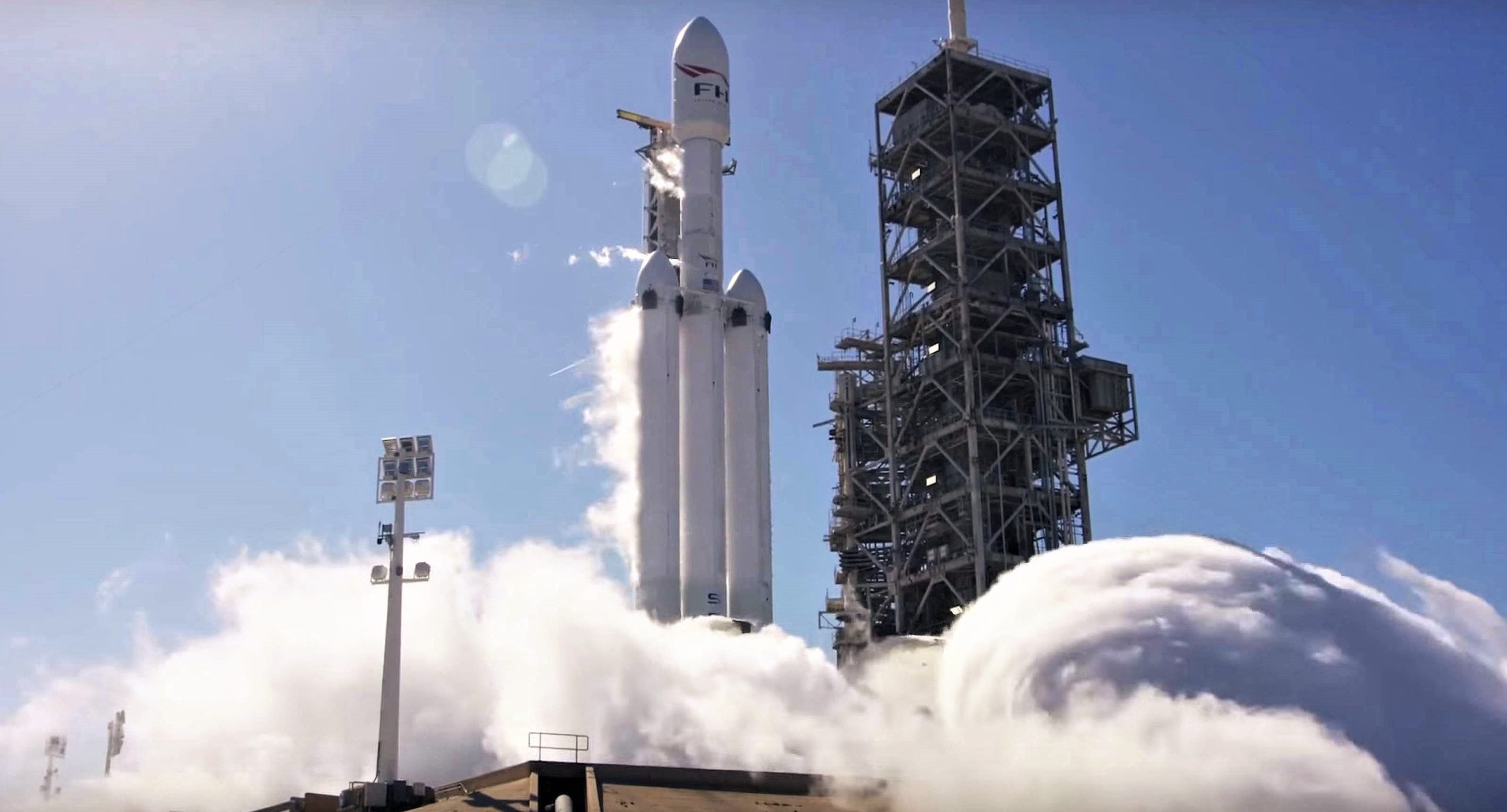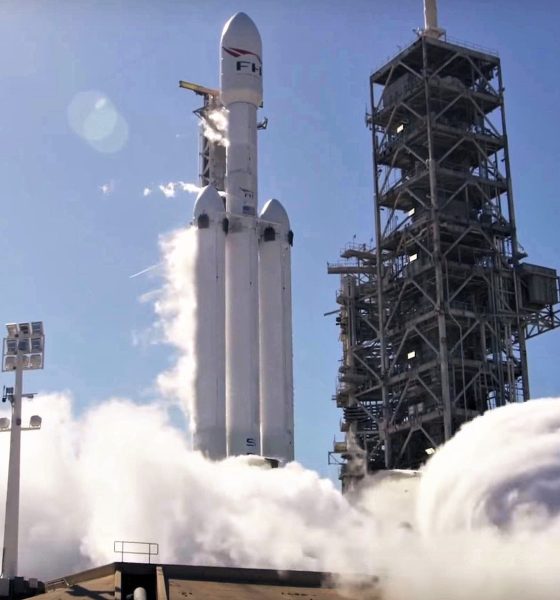

SpaceX
SpaceX’s Falcon Heavy to ignite all 27 Merlin engines in early morning test
SpaceX is set to take another stab at the first integrated static fire test of Falcon Heavy Block 5 rocket, a milestone that will open the doors for its commercial launch debut just a handful of days later.
The window for the second Falcon Heavy’s static fire test will open at
If all goes well during these relatively routine procedures, SpaceX can be expected to announce a date for Falcon Heavy’s second-ever launch, likely no sooner than 4-5 days after the static fire is completed. In other words, a flawless performance tomorrow could permit a launch date as early as April 9-10. Launching fewer than four days after completing static fire testing is rare even for Falcon 9, which has the luxury of far less complexity (and data produced) relative to Falcon Heavy, which has only flown once and
Three months after Falcon Heavy’s February 2018 debut, SpaceX debuted Falcon 9 in its upgraded Block 5 configuration, featuring widespread changes to avionics, software, structures, thermal protection, and even uprated thrust for its Merlin engines. Falcon Heavy Flight 1 was comprised of Block 2 and Block 3 variants of the Falcon 9’s umbrella V1.2 Full Thrust configuration, which debuted in December 2015. Both side boosters – Block 2s – were flight-proven and had previously launched in 2016, while the rocket’s heavily modified center core was effectively a new version of Falcon 9 based on Block 3 hardware.


One of the biggest goals of Block 5 / Version 6 is ease of reusability. In
And we have
Block 5 has improved payload to orbit. Improved redundancy. Improved reliability. It’s really better in every way than Block 4. I’m really proud of the SpaceX team for the design.
– SpaceX CEO Elon Musk, May 2018
A different different rocket
Given just how extensive the changes made with Block 5 are, Falcon Heavy Flight 2 is drastically different than its sole predecessor, emphasized by the 13+ months SpaceX has taken to go from Flight 1 to Flight 2. Had SpaceX been able to successfully recover Falcon Heavy’s first center core (B1033) after launch, its quite likely that the company would have attempted to refly the rocket’s three landed boosters a bit sooner than April 2019, but the booster’s failed landing threw a bit of a wrench in the production plan.
After intentionally expending almost a dozen recoverable Block 3 and 4 Falcon 9 boosters in 2017 and 2018, SpaceX’s fleet of flightworthy cores had been reduced to a tiny handful. Interrupting Falcon 9 Block 5’s production ramp would have likely become a bottleneck for 2018’s launch cadence, and may well have contributed to SpaceX falling short from its planned 30 and then 24 launches last year with a still-impressive 21. Building an entirely new Falcon Heavy center core was simply not a priority as SpaceX required all production hands on deck to build enough Block 5 boosters to avoid major launch delays.

As a result, SpaceX delayed the production of the first Falcon Heavy Block 5 center core by ~6 months and ~8 boosters, shipping the rocket – presumed to be B1055 – to McGregor, Texas for static fire acceptance testing in Q4 2018. The center core arrived in Florida in mid-February 2019, following both side cores and a payload fairing.
Ultimately, SpaceX is likely to conduct Falcon Heavy’s first commercial launch with about as much caution as could be observed during the unique launches of SSO-A (the first triple-
Stay tuned for an official SpaceX confirmation of Falcon Heavy’s second integrated static fire, as well as new launch date.
Check out Teslarati’s Marketplace! We offer Tesla accessories, including for the Tesla Cybertruck and Tesla Model 3.

Elon Musk
Starlink achieves major milestones in 2025 progress report
Starlink wrapped up 2025 with impressive growth, adding more than 4.6 million new active customers and expanding service to 35 additional countries, territories, and markets.

Starlink wrapped up 2025 with impressive growth, adding more than 4.6 million new active customers and expanding service to 35 additional countries, territories, and markets. The company also completed deployment of its first-generation Direct to Cell constellation, launching over 650 satellites in just 18 months to enable cellular connectivity.
SpaceX highlighted Starlink’s impressive 2025 progress in an extensive report.
Key achievements from Starlink’s 2025 Progress
Starlink connected over 4.6 million new customers with high-speed internet while bringing service to 35 more regions worldwide in 2025. Starlink is now connecting 9.2 million people worldwide. The service achieved this just weeks after hitting its 8 million customer milestone.
Starlink is now available in 155 markets, including areas that are unreachable by traditional ISPs. As per SpaceX, Starlink has also provided over 21 million airline passengers and 20 million cruise passengers with reliable high-speed internet connectivity during their travels.
Starlink Direct to Cell
Starlink’s Direct to Cell constellation, more than 650 satellites strong, has already connected over 12 million people at least once, marking a breakthrough in global mobile coverage.
Starlink Direct to Cell is currently rolled out to 22 countries and 6 continents, with over 6 million monthly customers. Starlink Direct to Cell also has 27 MNO partners to date.
“This year, SpaceX completed deployment of the first generation of the Starlink Direct to Cell constellation, with more than 650 satellites launched to low-Earth orbit in just 18 months. Starlink Direct to Cell has connected more than 12 million people, and counting, at least once, providing life-saving connectivity when people need it most,” SpaceX wrote.
Elon Musk
Starlink passes 9 million active customers just weeks after hitting 8 million
The milestone highlights the accelerating growth of Starlink, which has now been adding over 20,000 new users per day.

SpaceX’s Starlink satellite internet service has continued its rapid global expansion, surpassing 9 million active customers just weeks after crossing the 8 million mark.
The milestone highlights the accelerating growth of Starlink, which has now been adding over 20,000 new users per day.
9 million customers
In a post on X, SpaceX stated that Starlink now serves over 9 million active users across 155 countries, territories, and markets. The company reached 8 million customers in early November, meaning it added roughly 1 million subscribers in under seven weeks, or about 21,275 new users on average per day.
“Starlink is connecting more than 9M active customers with high-speed internet across 155 countries, territories, and many other markets,” Starlink wrote in a post on its official X account. SpaceX President Gwynne Shotwell also celebrated the milestone on X. “A huge thank you to all of our customers and congrats to the Starlink team for such an incredible product,” she wrote.
That growth rate reflects both rising demand for broadband in underserved regions and Starlink’s expanding satellite constellation, which now includes more than 9,000 low-Earth-orbit satellites designed to deliver high-speed, low-latency internet worldwide.
Starlink’s momentum
Starlink’s momentum has been building up. SpaceX reported 4.6 million Starlink customers in December 2024, followed by 7 million by August 2025, and 8 million customers in November. Independent data also suggests Starlink usage is rising sharply, with Cloudflare reporting that global web traffic from Starlink users more than doubled in 2025, as noted in an Insider report.
Starlink’s momentum is increasingly tied to SpaceX’s broader financial outlook. Elon Musk has said the satellite network is “by far” the company’s largest revenue driver, and reports suggest SpaceX may be positioning itself for an initial public offering as soon as next year, with valuations estimated as high as $1.5 trillion. Musk has also suggested in the past that Starlink could have its own IPO in the future.
News
SpaceX shades airline for seeking contract with Amazon’s Starlink rival

SpaceX employees, including its CEO Elon Musk, shaded American Airlines on social media this past weekend due to the company’s reported talks with Amazon’s Starlink rival, Leo.
Starlink has been adopted by several airlines, including United Airlines, Qatar Airways, Hawaiian Airlines, WestJet, Air France, airBaltic, and others. It has gained notoriety as an extremely solid, dependable, and reliable option for airline travel, as traditional options frequently cause users to lose connection to the internet.
Many airlines have made the switch, while others continue to mull the options available to them. American Airlines is one of them.
A report from Bloomberg indicates the airline is thinking of going with a Starlink rival owned by Amazon, called Leo. It was previously referred to as Project Kuiper.
American CEO Robert Isom said (via Bloomberg):
“While there’s Starlink, there are other low-Earth-orbit satellite opportunities that we can look at. We’re making sure that American is going to have what our customers need.”
Isom also said American has been in touch with Amazon about installing Leo on its aircraft, but he would not reveal the status of any discussions with the company.
The report caught the attention of Michael Nicolls, the Vice President of Starlink Engineering at SpaceX, who said:
“Only fly on airlines with good connectivity… and only one source of good connectivity at the moment…”
CEO Elon Musk replied to Nicolls by stating that American Airlines risks losing “a lot of customers if their connectivity solution fails.”
American Airlines will lose a lot of customers if their connectivity solution fails
— Elon Musk (@elonmusk) December 14, 2025
There are over 8,000 Starlink satellites in orbit currently, offering internet coverage in over 150 countries and territories globally. SpaceX expands its array of satellites nearly every week with launches from California and Florida, aiming to offer internet access to everyone across the globe.
Currently, the company is focusing on expanding into new markets, such as Africa and Asia.








